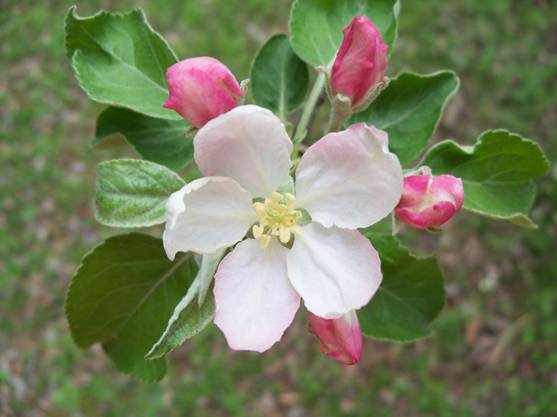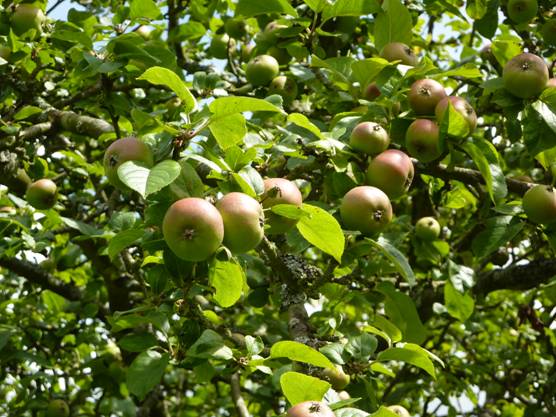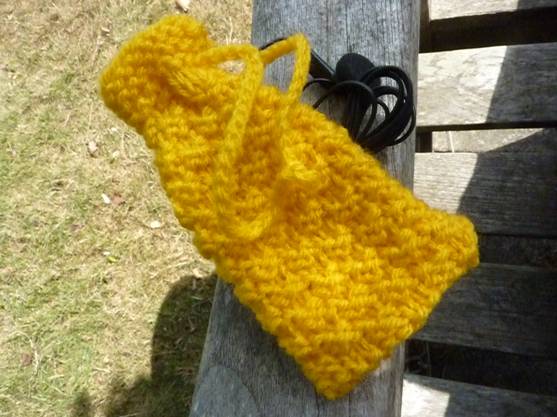
Salty Sam’s Fun Blog for Children
Number 236
Apples
Hello Everyone

ln my Auntie Alice’s garden, there are many fruit trees, and many of those are apple and pear trees.
Did you know that the apple tree belongs to the rose family?
lt originated in the mountains of central Asia but is now grown all over the world.
Apples may have first been cultivated by the Chinese and nearly half of apple production today takes place in China. Apples were brought to Britain by the Romans and taken to North America by European settlers.
Apple trees are large if grown from seed but much smaller if grafted onto rootstock. That means that the top of one tree is joined together to the roots of another. The roots used will determine the size the tree grows to. The join is made at the base of the trunk.
Apples are often grafted to produce new trees because when you plant pips they may not grow into a tree that is the same as the parents. Grafting gives a grower more control over what type of apple a tree will produce.
lf you see trees for sale in a shop or nursery, you will probably notice a lump in the trunk where the grafting took place.
Wild apples you see growing in hedgerows probably grew from a pip.
There are more than 7,500 cultivars of apples. Some are used for eating, some cooking and some to make an alcoholic drink called cider.
Apple trees have beautiful, delicate blossoms in spring. The fruits can be yellow, green, pink and red. lf they have a skin that has brownish tinge to it, this colour is called a russet.
Older cultivars are often tastier than modern ones. They can be odd shapes and darker colours than the ones you usually find in the shops, but they often don’t suit commercial growers because of characteristics they have.
For example they might be prone to disease, or won’t travel or store well, the trees might not produce lots of apples – although Cox’s Orange Pippin and Egremont Russet, two old types, are available in shops.
Luckily, there are now apple conservation groups around the world.
lf you are lucky enough to have room, you can choose to grow types of apples that you could not buy in the shops in your garden.
lf you grow an apple tree from a pip, you might grow an apple that has never existed before. Bramley apples were first grown in a garden in England. Granny Smith apples originated in Australia.
Maybe you are lucky enough to have apple trees in your garden already or are sometimes given fruit from other people’s trees. Did you know that these fresh apples can be stored way into the winter if you keep them in the right storage conditions?
Auntie Alice has an apple store in her garden which is a little shed positioned close to the house specially adapted for the purpose of storing apples. The varieties that ripen early don’t tend to keep well but the later varieties will. When October comes they all need to be picked and then they can be stored in your shed.
The children love to help Auntie Alice prepare apples for storage. lt is all hands to the pump at harvest time!
And anyway, they know there will be lots of lovely apple and pear dishes to eat through the winter when they come round to her house for tea.
No fruit is wasted; if any are bruised the good parts can be saved, cut up and made into fresh juices or chutney.
Nicely presented storage jars full of dried fruit or chutney make nice presents to give to people in the winter months. They can be put in food hampers for elderly people and make small thank you presents for neighbours who do you favours. Auntie Alice gives a lot of her fruit away.
Fruit left to rot on the ground is a terrible waste and won’t do a lawn any good either. lf you have too much fruit for your own needs, there will always be people only too pleased to receive some of your harvest.
There aren’t any food banks in Rocky Bay but there might be one near to you. Ask at food banks if they would like your fruit if you don’t have enough family and friends to share it with.
Bye bye everyone – don’t forget to subscribe to my blog!
lf you like my blog, please support it by telling all your friends and followers about it.
Thank you!
And see you again next Fun Friday!
Love and kisses
Salty Sam

www.christina-sinclair.com


Bill and Bob’s Joke of the Week![]()
![]()
Bill: lf l had five apples in one hand and ten apples in the other hand, what would l have?
Bob: Extremely big hands!

Salty Sam © Christina Sinclair 2015
Unauthorized use and/or duplication of material from this blog without express and written permission from this blog’s author and owner is strictly prohibited.
Links may be used to www.christina-sinclair.com

Picture Gallery
 Apple blossom
Apple blossom
 Apples are ripe to pick when they lift off the branch with no effort.
Apples are ripe to pick when they lift off the branch with no effort.
 Apple blossom
Apple blossom
 Apples growing on a tree
Apples growing on a tree


 THE SALTY SAM NEWS DESK
THE SALTY SAM NEWS DESK

Every time Auntie Alice sees a recipe for apples she collects it in a file of recipes.

When you have as many apples as she does in her garden, you want to find lots of different ways to use them!
Toffee apples are very popular but chocolate-covered apples are delicious as well.
Bill, Bob, Emily and Henry like them even better!
Auntie Alice pokes a stick into a fresh apple and then dips it in chocolate that she has melted in a bowl in a pan of hot water and then dips the top of the apple in coloured sprinkles.
Then she leaves the chocolate to set.
Yummy!


NEWSDESK MINIMAKE
EARPHONES POUCH
If you like sitting in the garden listening to music and get your earphones in a tangle, you may like to make this pouch to keep them neat and tidy.
EARPHONES POUCH (KNIT TWO)
Using 4mm knitting needles and dk yarn cast on 14 stitches
Knit 2 rows of garter stitch
Sl1 k2 p2 k2 p2 k2 p3
Sl1 k2 p2 k2 p2 k2 p3
Sl1 p2 k2 p2 k2 p2 k3
Sl1 p2 k2 p2 k2 p2 k3
Repeat last 4 rows 8 times
Garter stitch 6 rows
Cast off
TO MAKE UP
With right sides together and using over-sew stitching sew up the bottom and side seams
Crochet 60 chains into a length of yarn
Thread the cord through the base of the garter stitching top, tie the ends together and neaten the ends


*********************
TO ADVERTISE ON THIS BLOG
PLEASE CONTACT:
christina.sinclair.ads@aol.co.uk
*********************


Hobby Time
lf you have a harvest of apples and pears from your garden every year, it is possible to store the surplus through the winter months just by following a few simple guidelines.
The traditional way of storing apples and pears in a cool storeroom is still the best. lt is a good way of keeping a glut of fruit to eat through the winter. Some fruit will last a few weeks and some will last many months depending on which varieties you grow. Some late varieties actually need to be stored in order for them to ripen properly.
Finding a place with suitable conditions is really important for success. The temperature needs to be stable, below 10° Celsius and definitely frost-free. There should be good air circulation as well.
You can use a cool attic or cellar to store your apples and pears in. lf you want to use a shed or garage it must be insulated and should not contain any chemicals. Any room in a centrally-heated house will probably be too warm to be used as a fruit store.
lt is very important that your fruit store should not be accessible to mice or birds. lf you want to share some of your fruit with wildlife, it can be sliced up and left on a bird table, but an infestation of mice could ruin a whole store.
When choosing which fruit to store whole, it is important to only pick those specimens which are not damaged in any way. Any fruit that is bruised or has damaged skin can be processed and stored in other ways.
Wash the fruit well and dry it thoroughly because you don’t want to wrap any fruit up if it has moisture on the skin. Then wrap each fruit in a waxed paper such as baking paper. Cooking apples can be wrapped in newspaper but pears should be left unwrapped. The apples can be put into layers in boxes but the pears should not be touching each other. They must be stored in a single layer so that each fruit is completely surrounded by air.
lf you want to leave your apples unwrapped, they have to be kept isolated in the same way as the pears.
They will dry out more quickly but they will be easier to inspect.
The fruit must be checked on frequently, and any fruit that shows signs of deterioration should be removed from the store, but it need not be wasted altogether. Any bruised part of an apple or pear can be cut away and the rest of the fruit used for cooking.
The stored apples can be eaten as they are or baked or stewed.
You always need to label your trays with the name of the crop and a date if you add stock to your store at different times through the autumn. You may want to keep a record of which varieties last the longest and which should be eaten first in future years.
lndividual fruits that are not good candidates for storage can still be used in other ways; they just need more preparation. All the damaged parts should be cut away and put on the compost heap.
The parts that are undamaged can be cooked and the frozen puree made into desserts later. They can be juiced in a juice extractor and the juice can be frozen. They can be bottled in syrup or turned into chutney. They can be made into sauces. They can be oven dried and stored in jars.




lt’s the Weekend!

HOW TO MAKE DRlED FRUlT SNACKS
Drying is a simple method of preserving fruit and vegetables. Dried fruit can be a healthy alternative to sweets.
Drying fruit is an interesting way to store part of a summer or autumn harvest. It makes a change from making jam or pickles with your glut.

But of course you can use fruit from the supermarket as well.
These sweet, nutritious preserves can be made at home quite easily, stored for weeks and added as snacks to packed lunches for school. They can last from a few weeks to a few months. They must be totally dehydrated to ensure that no mould can develop.
Crops with a high-water content like apples, plums, grapes or tomatoes should be oven-dried but those with a low water content can just be dried indoors. This air-drying method is slower than using an oven but is particularly suited to herbs, chillies and also peas and beans that have been removed from their pods.
The room needs to be warm and well-ventilated. It could be a spare room or garage. A kitchen will have too much moisture in the air because of the steam from cooking.
To prepare fruit for oven drying, first wash it thoroughly and dry excess moisture from the skin.
Remove stones from plums and cores from apples. Halve plums and tomatoes, slice apples and strawberries and leave other berries whole. You can at this stage, dip your fruit into lemon juice to prevent browning.
Lay the pieces of fruit out onto a wire rack individually leaving air to circulate between them. If the berries are too small to sit on a wire rack, use a slightly-oiled baking tray instead.
Put your oven on its lowest setting and put the racks and trays inside. Open the door at intervals to lower the temperature and change the air. The purpose of the exercise is to dry the fruit not cook it.
Regularly check on the fruit, and after several hours, when the fruit feels light and dry to the touch, remove the racks from the oven and leave to cool completely.
Store the fruit in air-tight jars and store in a cool, dark place. It should last for several weeks.

Please note that the material on this blog is for personal use and for use in classrooms only.
It is a copyright infringement and, therefore, illegal under international law to sell items made with these patterns.
Use of the toys and projects is at your own risk.
©Christina Sinclair Designs 2015



